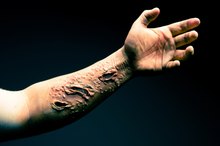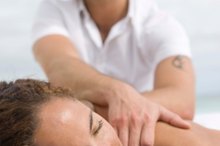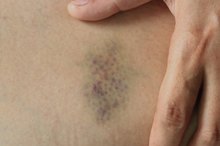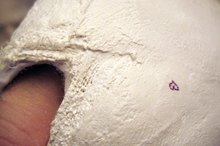Bruising After Deep Tissue Massage
Massage is an ancient practice that, over the centuries, has evolved into a wide range of techniques. One of the deeper and more intense forms of massage is deep tissue massage. In this technique, your therapist will progress deeper into the layers of your muscle and connective tissue, commonly referred to as fascia, to relieve tension. However, with all the benefits associated with deep tissue massage, there can also be side effects, such as bruising.
Bruising Basics
Bruises, also called muscle contusions, are areas of skin where the damage occurs to underlying muscle fibers or connective tissue, causing bleeding beneath the skin. Since the skin is not broken, the blood spreads out beneath the skin, giving the appearance of black, blue or purple on the surface. The more blood involved, the larger the bruise.
- Bruises, also called muscle contusions, are areas of skin where the damage occurs to underlying muscle fibers or connective tissue, causing bleeding beneath the skin.
- Since the skin is not broken, the blood spreads out beneath the skin, giving the appearance of black, blue or purple on the surface.
Deep Tissue Pressure
Salicylic Acid for Scar Removal
Learn More
Bruising with deep tissue massage is associated with the pressure your therapist uses on the muscle tissue. In deep tissue, the therapist focuses more on the underlying fascia beneath the muscle, using enough pressure to loosen up areas that have "stuck" together, commonly referred to as "knots." The pressure needed to successfully treat knots can result in the damage necessary to form a bruise. However, it is important to note that not all deep tissue massages end in bruising. Also, deep tissue massage may be slightly uncomfortable at times, but it is a misconception that deep tissue treatments are, or should be, painful. These treatments are meant to reduce pain, not create it.
- Bruising with deep tissue massage is associated with the pressure your therapist uses on the muscle tissue.
- However, it is important to note that not all deep tissue massages end in bruising.
Easily Bruised
Keep in mind that bruising will be more common if you have easily bruised skin, or you suffer from a condition which leaves your skin prone to bruising. For example, easy bruising becomes more common as you age due to aging capillaries and thinner skin. Blood conditions that cause clotting problems, or the use of medications like blood clotting drugs or corticosteroids, can also make your skin more likely to bruise from a deep tissue massage.
Alternatives
Can Massage Promote Weight Loss?
Learn More
Not all types of massage press as deeply into your muscle tissue 2. If you have sensitive skin that easily bruises, or if you suffer from a disorder that leaves you susceptible to bruising, consider a lighter massage technique. For example, a Swedish massage typically uses lighter pressure and longer strokes, placing less pressure on areas susceptible to bruising. You can also ask your therapist to use lighter pressure if you're experiencing pain.
- Not all types of massage press as deeply into your muscle tissue 2.
- You can also ask your therapist to use lighter pressure if you're experiencing pain.
Treatment
If you experience bruising from deep tissue massage, apply an ice or cold pack to the bruised skin several times a day for about 48 hours after the bruise occurs. If pain accompanies the bruises, use an over-the-counter pain medication, such as acetaminophen, or a non-steroidal anti-inflammatory like ibuprofen.
Related Articles
References
- University of Maryland Medical Center: Massage
- American Academy of Orthopaedic Surgeons: Muscle Contusion -- Bruise
- Romanowski MW, Špiritović M, Rutkowski R, Dudek A, Samborski W, Straburzyńska-lupa A. Comparison of Deep Tissue Massage and Therapeutic Massage for Lower Back Pain, Disease Activity, and Functional Capacity of Ankylosing Spondylitis Patients: A Randomized Clinical Pilot Study. Evid Based Complement Alternat Med. 2017;2017:9894128. doi:10.1155/2017/9894128
- Koren Y, Kalichman L. Deep tissue massage: What are we talking about? J Bodyw Mov Ther. 2018;22(2):247-251. doi:10.1016/j.jbmt.2017.05.006
- Tsao JC. Effectiveness of massage therapy for chronic, non-malignant pain: a review. Evid Based Complement Alternat Med. 2007;4(2):165-79. doi:10.1093/ecam/nel109
- Meknas K, Johansen O, Kartus J. Retro-trochanteric sciatica-like pain: current concept. Knee Surg Sports Traumatol Arthrosc. 2011;19(11):1971-85. doi: 10.1007/s00167-011-1573-2
- Brummitt J. The role of massage in sports performance and rehabilitation: current evidence and future direction. N Am J Sports Phys Ther. 2008;3(1):7-21.
- Crump C, Paluska SA. Venous thromboembolism following vigorous deep tissue massage. Phys Sportsmed. 2010;38(4):136-9. doi:10.3810/psm.2010.12.1836
- Yin P, Gao N, Wu J, Litscher G, Xu S. Adverse events of massage therapy in pain-related conditions: a systematic review. Evid Based Complement Alternat Med. 2014;2014:480956. doi:10.1155/2014/480956
- Massage Therapy for Health Purposes. National Center for Complementary and Integrative Health. NIH.
- Romanowski M, Romanowska J, Grześkowiak M. A comparison of the effects of deep tissue massage and therapeutic massage on chronic low back pain. Stud Health Technol Inform. 2012.
Writer Bio
Chris Sherwood is a professional journalist who after years in the health administration field and writing health and wellness articles turned towards organic sustainable gardening and food education. He now owns and operates an organic-method small farm focusing his research and writing on both organic gardening methods and hydroponics.







